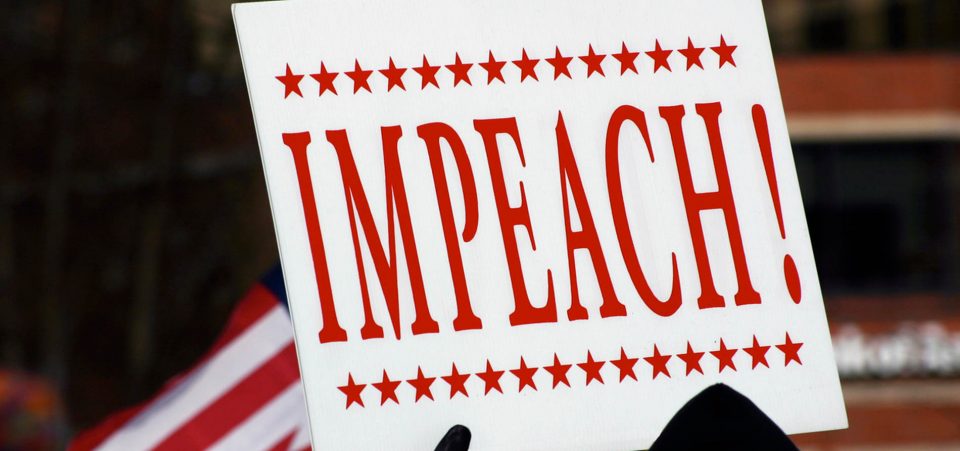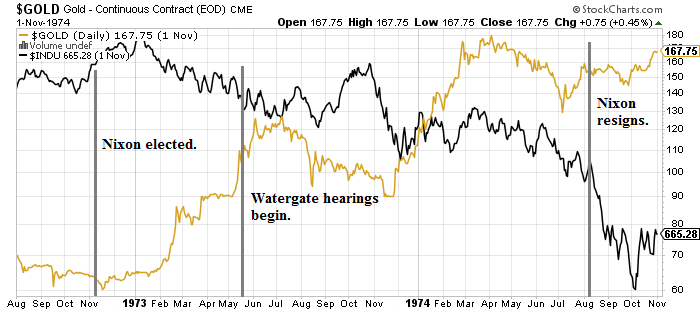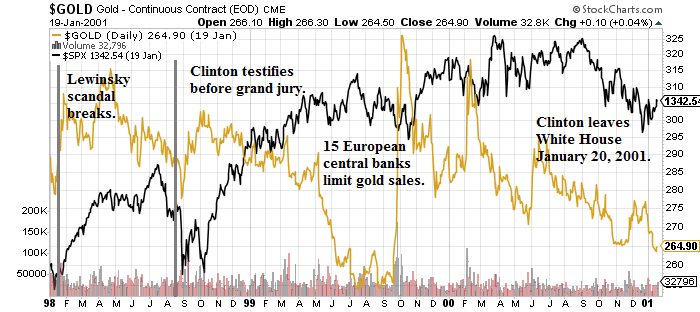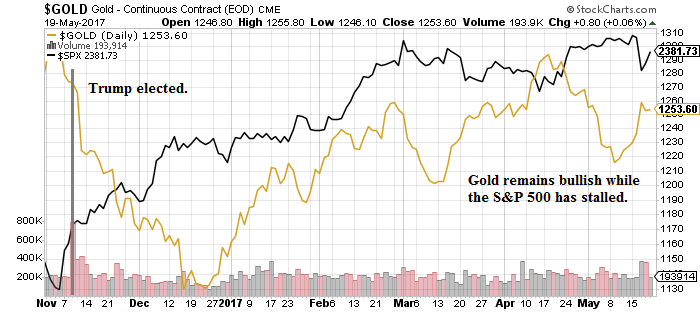Gold Prices Outlook for 2017
Stocks are suffering their worst bout of 2017, with the Dow Jones Industrial Average (DJIA), S&P 500, and NASDAQ retracing from record highs. Precious metals like gold and silver, on the other hand, have rebounded. Stocks are lagging and gold is advancing because investors are digesting the news out of the White House and deciding whether the current turmoil that is embattling the Donald Trump administration could possibly lead to an impeachment.
While chances of an impeachment appear remote, it’s a good idea to look at previous White House scandals to see how the stock markets responded, and to see what happened to gold prices.
President Richard Nixon
The most famous impeachment hearing of the 20th century, and the one that led to a president stepping down, belongs to President Richard Nixon. In October 1973, Nixon fired the special prosecutor who was investigating the failed break-in at the Democratic National Committee headquarters at the Watergate complex in Washington, D.C. in June 1972.
The Watergate fiasco shone a light on Nixon’s abuses of power, including wiretapping and investigating political opponents. Ultimately, Nixon resigned as president of the U.S. on August 9, 1974, before he could be impeached.
How did the stock market and gold prices act during the chaotic Watergate process? The stock market enjoyed a small “Nixon bump” following his election win. A week after the November 7, 1972 election, the DJIA hit 1,000. The rally continued into the next year, when the Dow Jones hit an intra-day high of 1,053.21 on January 9, 1973.
Chart courtesy of StockCharts.com
Eventually, the rally died and the DJIA ended 1973 at around 850, a 19% decline over the January high. Gold, on the other hand, advanced 72.5% in 1973. Gold was bullish, due to the Watergate scandal and the oil crisis.
The DJIA’s losing streak continued into 1974. On August 9, 1974, the day Nixon resigned, the Dow Jones closed at approximately 777; by early October, the DJIA had fallen to 573.22. From the January 9, 1973 peak to the October 4, 1974 bottom, the Dow Jones lost 40% of its value.
Over the same time frame, gold prices continued to rally. Between January 1 and August 9, 1974, the prices increased 32.5% to $154.525 per ounce. By October 4, the price of gold had reached $159.00 per ounce. Also over the same time frame, the prices soared 144%.
President Bill Clinton
The most recent impeachment hearings belong to President Bill Clinton. In early January 1998, Monica Lewinsky filed an affidavit in the Paula Jones case, who was suing the president for sexual harassment. Lewinsky denied ever having a sexual relationship with President Clinton.
On January 17, 1998, the Lewinsky scandal broke; Clinton denied the allegations, and a scandal was born. On January 26, Clinton publicly stated, “I did not have sexual relations with that woman, Monica Lewinsky.” Word leaked out that Lewinsky may have misspoken about having an affair with the president, and she eventually accepted an immunity deal in the case.
On August 6, 1998, Lewinsky appeared before a grand jury to begin her testimony. On August 17, 1998, Clinton became the first sitting president to testify before a grand jury regarding his behavior. Later that day, he had an epiphany and admitted that he did, in fact, have an inappropriate relationship with Lewinsky.
By late September 1998, the House Judiciary Committee announced it would consider a resolution to begin an impeachment inquiry against Clinton. On December 19, 1998, the House of Representatives approved two articles of impeachment against Clinton, charging him with lying under oath and obstructing justice.
We know how the story ended; the prosecution needed a two-thirds majority to convict, but failed to even achieve a majority. Clinton finished his term as president.
Now, what did the broader markets and gold do during this chaotic period in presidential history? Suffice it to say, investors reacted a lot differently than during Nixon’s Watergate saga.
Chart courtesy of StockCharts.com
During Clinton’s 1998–1999 impeachment process, the stock market did pretty well. From the beginning of 1998—when the Lewinsky story broke—to the end of 1999, the S&P 500 increased 51%, from 971.08 to 1469.20. By the time Clinton left office on January 20, 2001, the S&P 500 had advanced 38% since the Lewinsky scandal started.
Gold prices, on the other hand, were on a roller coaster ride. At the start of 1998, gold was changing hands at $289.40. By January 29, a couple days after Clinton’s “I did not have sexual relations” speech, gold hit an intra-day high of $308.50 per ounce, for a one-month gain of 6.5%. In early May 1998, gold hit an intra-day high of $316.80 an ounce; a four-month gain of 9.5%.
The most exciting thing to happen to gold during the impeachment process took place in late September 1999, when gold hit a two-year high of 4,338 after 15 European central banks agreed to limit gold sales. Even that was a short-lived affair.
By the time Clinton’s second term had finished, gold prices had fallen to $264.90 per ounce, an 8.5% decline over where the prices were just before the Lewinsky scandal broke.
Because the Clinton/Lewinsky scandal was such a long, drawn-out affair, there was no real urgency for investors to support gold. If anything, many Americans were bored by the whole thing and didn’t think that an impeachment would undermine the U.S. economy or national security.
President Donald Trump
As for President Donald Trump, the chaos surrounding his administration has not been simmering for a long time like it did with Clinton. But it’s going at a much quicker pace than with Nixon.
In just a matter of days, the White House abruptly fired FBI Director James Comey, a move that Trump said was motivated in part by an investigation into the Russia controversy. Less than 24 hours later, Trump shared highly-classified information with a Russian envoy. It then emerged that Trump had tried to pressure Comey to drop his investigation into ex-National Security Advisor Michael Flynn’s relationship with Russia.
On May 17, the U.S. Department of Justice announced it had appointed a special counsel to investigate a possible coordination between Trump’s associates and Russian officials. The White House might not believe there is any need for a special investigator to look into possible collusion with the Kremlin, but federal investigators are not so sure.
Investors may have been keen to ignore weak U.S. economic data and geopolitical tensions with North Korea, Syria, and Russia, but they do not seem quite as eager to shrug off the current chaos on Capitol Hill.
Chart courtesy of StockCharts.com
The S&P took off after Trump won the U.S election in November 2016, with many believing that his tax cuts and stimulus plans would be good for corporate profits and the U.S. economy. From election day in 2016 to the beginning of March 2017, the S&P 500 advanced approximately 11%. Since then, however, the S&P 500 hasn’t really moved.
If anything, the S&P 500 has been giving up ground on fears that the current troubles circling Trump could morph into something bigger. Moreover, there are concerns that these issues will overshadow and prevent Trump from getting his proposed tax cuts and stimulus packages enacted.
Gold, on the other hand, is experiencing a Renaissance. Gold started out strong in 2016, but faded after Trump won the U.S. election. Gold ended 2016 up 8.5%, but that’s a far cry from the 30% gains that gold was enjoying in August 2016.
It’s a different story in 2017. Again, there are concerns that Trump will not be able to get his campaign promises through Congress. Moreover, there is ongoing uncertainty about how long the issues plaguing the Trump administration will continue to distract from his presidency.
Since January 1, gold prices have advanced nine percent to $1,253 per ounce.
Because of the ongoing scandals and gridlock in Washington, there’s a good chance that Trump will not be able to get his tax cuts through Congress until maybe 2018. This would make it virtually impossible for Trump to achieve his campaign promise to get U.S. annual gross domestic product (GDP) growth to a sustainable range of three-to-four percent.
Failing to get the U.S. economy going, which suffered under Barack Obama, could undermine U.S. corporate earnings and be the death knell to the long-suffering bull market. Optimistic investors have been supporting the bull market on the hopes that Trump’s economic policies will kick-start the U.S. economy. The sharks circling Capitol Hill will most certainly put Trump’s tax cuts, healthcare plan, and stimulus spending on hold.
U.S. corporate earnings are already fragile. First-quarter earnings may look decent, but it’s only because we were in an earnings recession a year ago. S&P 500 companies looking for sustainable earnings growth need to avoid the United States.
In the first quarter of 2017, S&P 500 companies that rely on overseas sales for more than half of their revenue were reporting average earnings per share (EPS) growth of 20.9%. S&P 500 companies that rely on the U.S. for the majority of their revenue are reporting average first-quarter EPS growth of only 9.9%. (Source: “Earnings Insight,” FactSet Research Systems Inc., May 12, 2017.)
The speed with which the scandals are adding up, and the growing uncertainty, are making this scenario much more dire than those that engulfed Nixon or Clinton. It doesn’t mean any of this will result in an impeachment, but the appearance of impropriety is enough to rattle the U.S. and global markets, put the stock market in jeopardy, and put the shine back on gold.
If Trump is impeached though, the S&P 500 would get crushed and gold prices could more than double.









